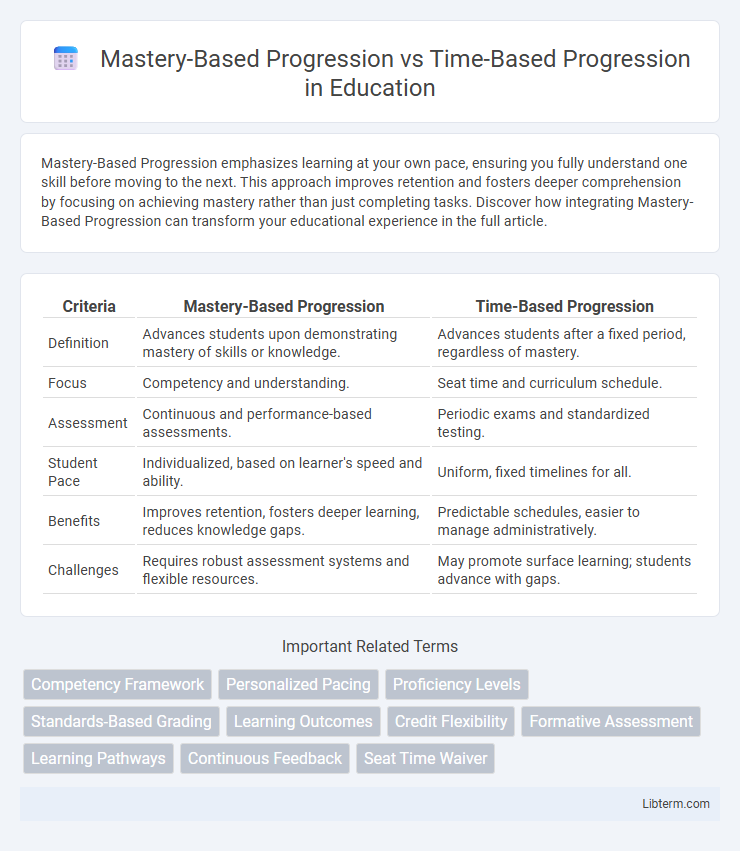Mastery-Based Progression emphasizes learning at your own pace, ensuring you fully understand one skill before moving to the next. This approach improves retention and fosters deeper comprehension by focusing on achieving mastery rather than just completing tasks. Discover how integrating Mastery-Based Progression can transform your educational experience in the full article.
Table of Comparison
| Criteria | Mastery-Based Progression | Time-Based Progression |
|---|---|---|
| Definition | Advances students upon demonstrating mastery of skills or knowledge. | Advances students after a fixed period, regardless of mastery. |
| Focus | Competency and understanding. | Seat time and curriculum schedule. |
| Assessment | Continuous and performance-based assessments. | Periodic exams and standardized testing. |
| Student Pace | Individualized, based on learner's speed and ability. | Uniform, fixed timelines for all. |
| Benefits | Improves retention, fosters deeper learning, reduces knowledge gaps. | Predictable schedules, easier to manage administratively. |
| Challenges | Requires robust assessment systems and flexible resources. | May promote surface learning; students advance with gaps. |
Understanding Mastery-Based Progression
Mastery-Based Progression emphasizes students achieving a deep understanding of concepts before advancing, allowing personalized pacing that accommodates individual learning speeds. This model contrasts with Time-Based Progression, where all students move forward after a fixed period regardless of mastery, often leading to gaps in knowledge. By prioritizing mastery, educational systems improve retention, critical thinking, and long-term academic success.
Defining Time-Based Progression
Time-Based Progression refers to an educational model where the advancement of students is determined by a fixed schedule, typically measured in hours, weeks, or semesters, regardless of individual mastery of the content. This traditional approach emphasizes seat time as the primary metric for moving through the curriculum, often leading to varied levels of understanding among students at the same stage. In contrast to mastery-based systems, time-based progression can result in learners advancing without fully mastering key concepts, potentially impacting long-term retention and skill application.
Core Principles of Mastery-Based Learning
Mastery-Based Progression centers on achieving specific competencies before advancing, ensuring learners fully understand material through personalized pacing and continuous assessment. Core principles include clear learning objectives, iterative feedback, and the opportunity for remediation, which contrasts sharply with Time-Based Progression's fixed schedules regardless of mastery. This approach enhances retention and skill application by prioritizing depth of knowledge over seat time.
Key Features of Time-Based Educational Models
Time-based educational models are characterized by a fixed schedule where students progress according to calendar time rather than individual mastery, typically advancing annually regardless of skill acquisition. This model emphasizes seat time, standardized testing milestones, and uniform pacing, often leading to varied levels of student understanding within the same cohort. Core features include structured curriculum sequencing, predetermined instructional periods, and reliance on summative assessments for grade promotion.
Advantages of Mastery-Based Progression
Mastery-Based Progression enables learners to advance only after demonstrating a thorough understanding of the material, ensuring deeper knowledge retention and skill acquisition. This approach personalizes education by allowing students to learn at their own pace, reducing gaps in understanding and promoting confidence. Studies show higher engagement and improved outcomes in mastery-based systems compared to traditional time-based progression models.
Challenges Associated with Time-Based Progression
Time-based progression often struggles with varying learner paces, leading to inadequate skill mastery and increased dropout rates. Fixed timelines may pressure students to advance without fully grasping concepts, resulting in knowledge gaps and lower retention. This approach can hinder personalized learning, reducing engagement and overall educational effectiveness.
Impact on Student Engagement and Motivation
Mastery-Based Progression boosts student engagement and motivation by allowing learners to advance at their own pace, ensuring thorough understanding before moving forward. This personalized approach reduces frustration and increases confidence, leading to higher intrinsic motivation compared to the rigid constraints of Time-Based Progression. Research from the American Educational Research Association shows that mastery-based models result in greater persistence and deeper cognitive engagement among students.
Assessment Strategies in Both Systems
Mastery-based progression employs formative assessments that provide detailed feedback and ensure students achieve specific competencies before advancing, emphasizing personalized learning paths and mastery checks. Time-based progression relies primarily on summative assessments aligned with fixed grading periods, often prioritizing seat time and coverage of curriculum over individual mastery. Effective assessment strategies in mastery-based systems include frequent quizzes, performance tasks, and self-assessments, while time-based systems typically utilize standardized tests and end-of-term exams to measure student progress.
Real-World Applications and Examples
Mastery-Based Progression enables learners to advance upon demonstrating competence, enhancing skill retention and real-world problem-solving as seen in medical training where students must master procedures before moving forward. Time-Based Progression, commonly used in traditional education, allows students to progress after spending set time periods in courses regardless of mastery, which can lead to gaps in applied knowledge. Industries like software development increasingly favor mastery models, as demonstrated by coding bootcamps requiring project completion for certification, ensuring job-ready skills.
Choosing the Right Progression Model
Choosing the right progression model involves evaluating the learner's needs, subject complexity, and desired outcomes between mastery-based and time-based progression. Mastery-based progression ensures competency by allowing learners to advance only after demonstrating proficiency, which improves skill retention and personalized learning experiences. Time-based progression follows a fixed schedule, promoting consistent pacing but potentially overlooking individual learning differences and mastery levels.
Mastery-Based Progression Infographic

 libterm.com
libterm.com